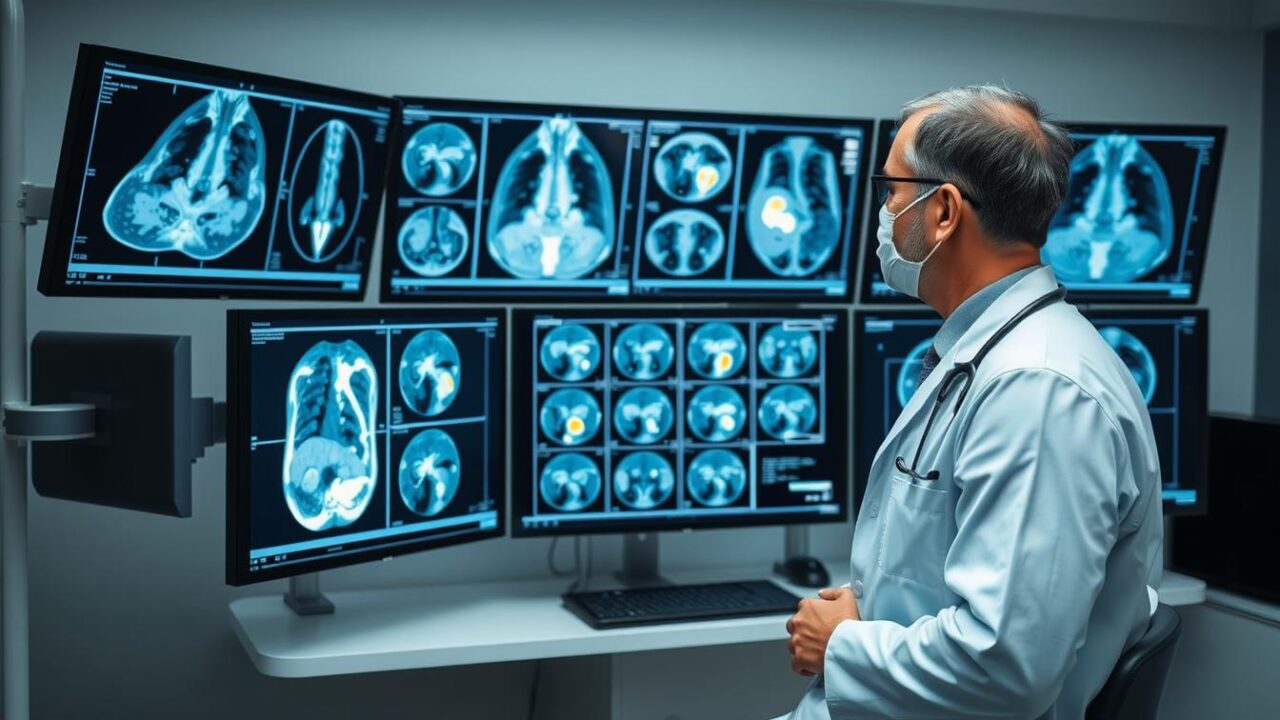Artificial intelligence is no longer a vision of the future; it’s the driving force of the present, fundamentally transforming industries and redefining how we work, live, and innovate. According to McKinsey, AI is currently on track to automate up to 30% of hours worked in the US economy while necessitating up to 12 million occupational transitions. This technological revolution is expected to contribute as much as $15.7 trillion to the global economy by 2030, underscoring the transformative impact AI is having across various sectors.
From enhancing diagnostic accuracy in healthcare to streamlining supply chain operations in retail, AI is accelerating progress and unlocking unprecedented opportunities. However, these advancements demand more than mere technological adoption—they call for strategic implementation, ethical foresight, and an unwavering commitment to innovation. In this article, we’ll explore how AI is driving change in six pivotal industries, offering insights into how organizations can harness its potential to create radical efficiency and competitive advantage.
Healthcare: AI Transforming Patient Care and Diagnosis
Few industries are as ripe for disruption as healthcare. The integration of AI is transforming everything from diagnostics to patient care, creating a system that is faster, more accurate, and increasingly personalized.
Specific AI Applications in Healthcare
- AI-powered diagnostic tools that analyze medical imaging with remarkable precision, detecting conditions like cancer, heart disease, and neurological disorders earlier than human practitioners
- Predictive analytics systems that identify patterns to anticipate disease outbreaks and allocate resources more effectively
- Administrative automation tools that streamline scheduling, insurance verification, and medical coding
- Personalized treatment recommendation systems that analyze patient data to suggest optimal care pathways
Real-World Examples
Google DeepMind’s AlphaFold
This AI system has revolutionized protein structure prediction, a critical component in drug discovery and development. AlphaFold can predict protein structures with near-experimental accuracy, dramatically accelerating pharmaceutical research timelines.
Zebra Medical Vision
This company uses AI to analyze medical imaging data, helping radiologists identify diseases like breast cancer and osteoporosis with greater accuracy. Their algorithms can detect subtle patterns that might be missed by the human eye.
Benefits and Challenges
Benefits
- Earlier disease detection leading to improved patient outcomes
- Reduced diagnostic errors and healthcare costs
- More efficient allocation of medical resources
- Personalized treatment plans based on individual patient data
Challenges
- Data privacy and security concerns
- Integration with existing healthcare systems
- Regulatory approval processes
- Potential for algorithmic bias in diagnosis
Stay Updated on AI Healthcare Innovations
Get exclusive insights on how AI is transforming healthcare delivery and patient outcomes. Our monthly newsletter brings you the latest developments, case studies, and implementation strategies.
Finance: AI-Powered Risk Assessment and Fraud Detection

The finance industry has been an early adopter of AI technologies, leveraging them to enhance decision-making, improve risk assessment, and detect fraudulent activities with unprecedented accuracy.
Specific AI Applications in Finance
- Advanced fraud detection systems that analyze transaction patterns in real-time to identify suspicious activities
- AI-driven risk assessment tools that evaluate loan applications based on a broader range of factors than traditional credit scores
- Algorithmic trading platforms that execute trades at optimal times based on market analysis
- Customer service chatbots that handle routine banking inquiries and transactions
Real-World Examples
JPMorgan’s COIN (Contract Intelligence)
This machine learning system reviews legal documents and extracts important data points, completing in seconds what previously took legal experts 360,000 hours annually. The system has dramatically improved accuracy and efficiency in document review.
Bank of America’s Erica
This AI-powered virtual assistant handles over 2 million client interactions daily, helping with tasks such as monitoring subscriptions, providing spending insights, and assisting with money transfers.
Benefits and Challenges
Benefits
- Significant reduction in fraudulent transactions
- More accurate risk assessment for lending decisions
- Enhanced customer experience through personalized services
- Improved operational efficiency and cost reduction
Challenges
- Regulatory compliance and explainability requirements
- Potential for algorithmic bias in lending decisions
- Cybersecurity concerns as systems become more complex
- Workforce displacement in traditional banking roles
Master AI-Driven Financial Strategies
Discover how leading financial institutions are implementing AI to drive growth and reduce risk. Our expert-led webinars provide actionable insights for finance professionals.
Manufacturing: AI Revolutionizing Production and Quality Control
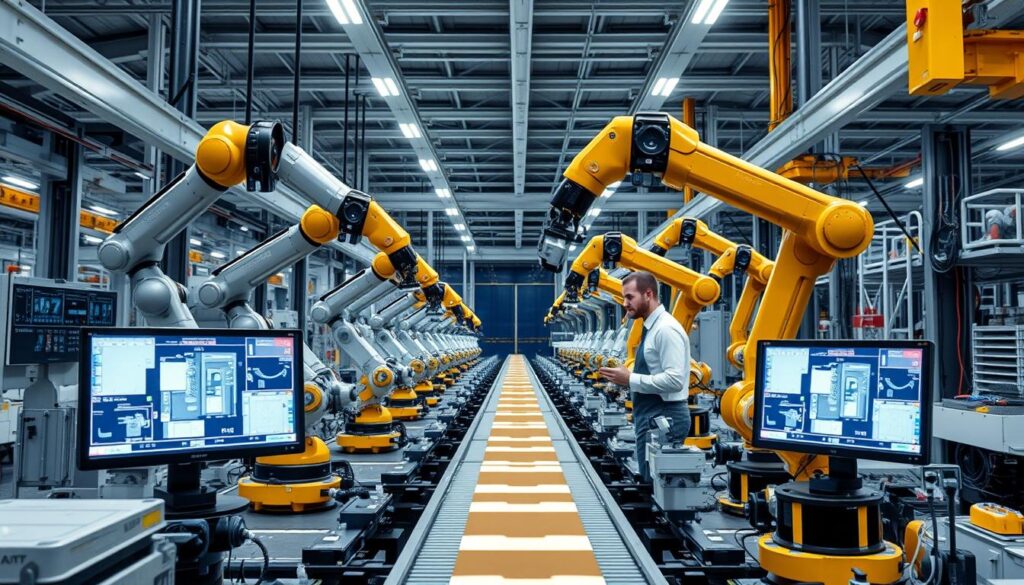
The manufacturing sector is experiencing a profound transformation through AI implementation, particularly in predictive maintenance, quality control, and supply chain optimization. Industry 4.0 initiatives are increasingly centered around AI capabilities that enhance efficiency and reduce downtime.
Specific AI Applications in Manufacturing
- Predictive maintenance systems that analyze equipment data to forecast failures before they occur
- Computer vision quality control that identifies defects with greater accuracy than human inspection
- Digital twins that simulate production processes to optimize efficiency
- Supply chain optimization algorithms that predict demand and manage inventory levels
Real-World Examples
Siemens’ AI-Powered Factories
Siemens has implemented AI systems in its manufacturing facilities that reduce unplanned downtime by up to 30% through predictive maintenance. Their systems analyze sensor data from equipment to predict failures before they occur.
BMW’s Quality Control AI
BMW uses computer vision AI to inspect components during production, detecting defects that might be missed by human inspectors. The system processes thousands of images per second to identify even minor imperfections.
Benefits and Challenges
Benefits
- Reduced downtime through predictive maintenance
- Improved product quality and consistency
- Optimized inventory management and reduced waste
- Enhanced worker safety through automation of dangerous tasks
Challenges
- High initial implementation costs
- Integration with legacy manufacturing systems
- Workforce training and transition challenges
- Data quality issues in older facilities
Transform Your Manufacturing Operations
Learn how AI is revolutionizing manufacturing efficiency and quality control. Our industry reports provide detailed implementation roadmaps and ROI analyses.
Retail: AI Enhancing Customer Experience and Inventory Management

The retail industry is leveraging AI to create personalized shopping experiences, optimize inventory management, and streamline operations. With global spending on AI in e-commerce set to reach $16.8 billion by 2030, retailers are rapidly adopting these technologies to stay competitive.
Specific AI Applications in Retail
- Personalized recommendation engines that analyze customer behavior to suggest relevant products
- Inventory optimization systems that predict demand and automate restocking
- Visual search capabilities that allow customers to find products based on images
- Dynamic pricing algorithms that adjust prices based on demand, competition, and other factors
Real-World Examples
Amazon’s Recommendation Engine
Amazon’s AI-powered recommendation system generates 35% of the company’s revenue by analyzing customer browsing history, purchase patterns, and even social media activity to suggest highly relevant products.
Walmart’s Inventory Management
Walmart uses AI to optimize inventory across its stores, analyzing factors like local events, weather patterns, and historical sales data to ensure products are available when and where customers need them.
Benefits and Challenges
Benefits
- Enhanced customer experience through personalization
- Reduced inventory costs and stockouts
- Improved operational efficiency in supply chain management
- Increased sales through targeted marketing and recommendations
Challenges
- Privacy concerns related to customer data collection
- Integration with existing retail systems
- Balancing automation with human customer service
- Keeping pace with rapidly evolving consumer expectations
Elevate Your Retail Strategy with AI
Discover how leading retailers are using AI to drive sales and improve customer loyalty. Our specialized newsletter delivers actionable retail AI insights directly to your inbox.
Agriculture: AI Optimizing Crop Yields and Resource Management

The adoption of AI in agriculture is marking a significant leap in how we cultivate food and manage natural resources. From precision farming to automated harvesting, AI technologies are helping farmers increase yields while reducing environmental impact.
Specific AI Applications in Agriculture
- Crop and soil monitoring systems that analyze data from satellites, sensors, and drones
- Predictive analytics for weather patterns and crop disease outbreaks
- Automated irrigation systems that optimize water usage based on soil conditions
- Agricultural robots for planting, weeding, and harvesting
Real-World Examples
Blue River Technology
This company’s See & Spray technology uses computer vision and machine learning to identify weeds and precisely apply herbicides only where needed, reducing chemical usage by up to 90% while maintaining crop health.
Taranis
Taranis uses AI-powered drones and image recognition to monitor crop health, identifying issues like nutrient deficiencies, pests, and diseases at an early stage when intervention is most effective.
Benefits and Challenges
Benefits
- Increased crop yields and quality
- Reduced use of water, fertilizers, and pesticides
- Early detection of crop diseases and pests
- More sustainable farming practices
Challenges
- High implementation costs for small farmers
- Limited rural connectivity and infrastructure
- Training requirements for traditional farmers
- Data ownership and privacy concerns
Grow Smarter with Agricultural AI
Learn how AI is transforming farming practices and improving sustainability. Our expert guides provide practical implementation strategies for farms of all sizes.
Logistics: AI Transforming Supply Chain and Transportation
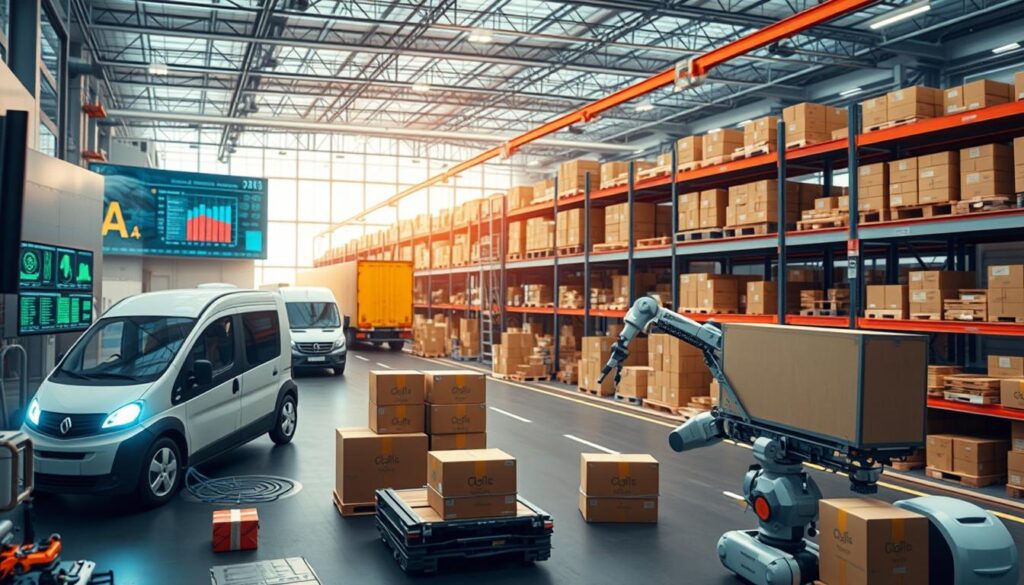
The logistics and transportation industry is undergoing a seismic shift driven by AI technologies that promise to revolutionize mobility and supply chain management. From autonomous vehicles to route optimization, AI is transforming how people and goods move across the globe.
Specific AI Applications in Logistics
- Route optimization algorithms that consider traffic, weather, and delivery priorities
- Predictive maintenance for transportation fleets
- Warehouse automation with AI-powered robots and sorting systems
- Demand forecasting for more efficient inventory management
Real-World Examples
DHL’s AI-Powered Logistics
DHL has implemented AI for predictive network planning, which analyzes historical data and external factors to optimize delivery routes and schedules, reducing fuel consumption and delivery times.
Waymo’s Autonomous Vehicles
Waymo’s self-driving technology uses AI to navigate complex traffic situations, promising to revolutionize both passenger transportation and freight delivery with increased safety and efficiency.
Benefits and Challenges
Benefits
- Reduced transportation costs through optimized routing
- Decreased delivery times and improved reliability
- Lower environmental impact through efficient resource use
- Enhanced tracking and visibility throughout the supply chain
Challenges
- Regulatory hurdles for autonomous transportation
- Integration across complex global supply chains
- Job displacement concerns in transportation sectors
- Cybersecurity risks in connected logistics systems
Optimize Your Supply Chain with AI
Discover how AI is revolutionizing logistics and transportation efficiency. Our industry experts provide customized assessments to identify your biggest opportunities.
Pre-AI vs. Post-AI: The Transformation of Industries
| Industry | Pre-AI Workflow | Post-AI Workflow | Key Improvements |
| Healthcare | Manual review of medical images, symptom-based diagnosis, standardized treatments | AI-assisted image analysis, data-driven diagnosis, personalized treatment plans | 50% faster diagnosis, 30% reduction in misdiagnosis, personalized medicine |
| Finance | Rule-based fraud detection, credit score-based lending, manual document processing | Pattern-based fraud detection, holistic risk assessment, automated document analysis | 60% reduction in fraud, broader access to credit, 90% faster document processing |
| Manufacturing | Scheduled maintenance, manual quality inspection, reactive supply chain | Predictive maintenance, automated quality control, proactive supply chain | 40% less downtime, 25% quality improvement, 35% inventory optimization |
| Retail | Demographic-based marketing, periodic inventory checks, fixed pricing | Personalized recommendations, automated inventory, dynamic pricing | 35% increase in conversion rates, 45% reduction in stockouts, optimized margins |
| Agriculture | Experience-based planting, uniform irrigation, reactive pest control | Data-driven planting decisions, precision irrigation, predictive pest management | 20% yield increase, 30% water conservation, 50% reduction in pesticide use |
| Logistics | Fixed routes, scheduled maintenance, manual tracking | Dynamic route optimization, predictive maintenance, automated tracking | 15% fuel savings, 25% maintenance cost reduction, real-time visibility |
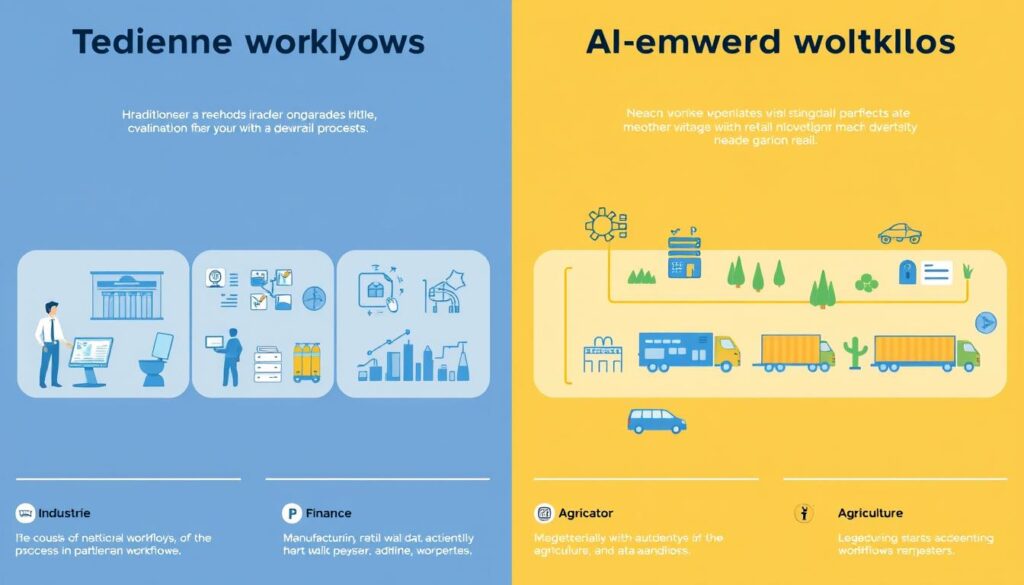
The Future of AI Across Industries: What’s Next?
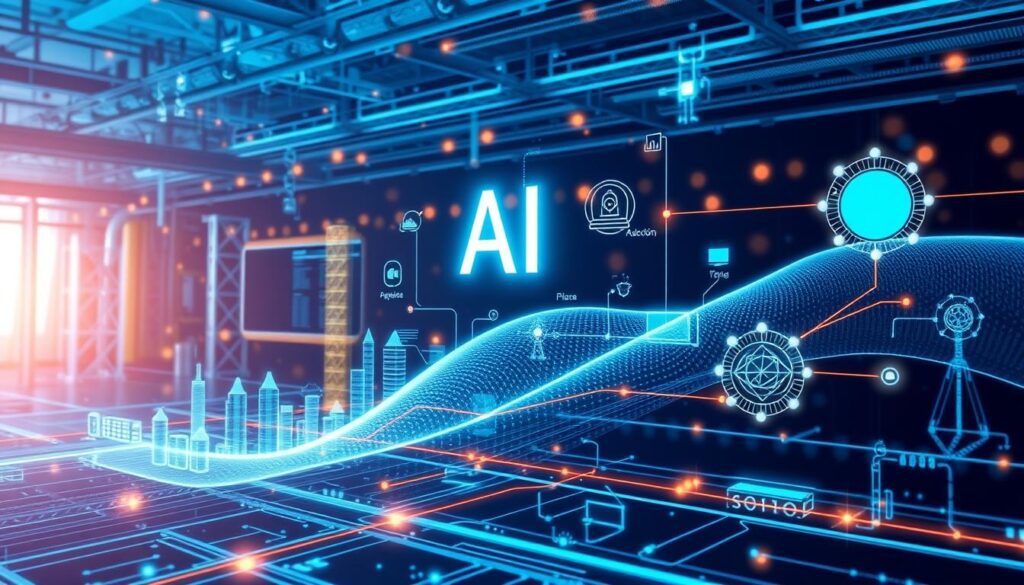
As AI continues to evolve, we can expect even more profound transformations across industries. Several emerging trends will likely shape the next wave of AI innovation:
- Explainable AI: As regulatory scrutiny increases, AI systems will need to provide clear explanations for their decisions, particularly in sensitive areas like healthcare and finance.
- Edge AI: Processing data locally on devices rather than in the cloud will enable faster response times and enhanced privacy, critical for applications like autonomous vehicles and industrial IoT.
- AI Collaboration: Rather than replacing humans, the most successful AI implementations will focus on augmenting human capabilities, creating collaborative systems that leverage the strengths of both.
- Cross-Industry AI: Solutions developed for one industry will increasingly find applications in others, accelerating innovation through knowledge transfer.
Organizations that embrace these trends and develop strategic approaches to AI implementation will be best positioned to thrive in an increasingly AI-driven economy. The key will be balancing technological innovation with ethical considerations, workforce development, and clear business objectives.
While AI promises tremendous benefits across industries, organizations must approach implementation thoughtfully, considering not just the technological aspects but also the human, ethical, and strategic dimensions. Success will come to those who view AI not as a standalone solution but as part of a broader digital transformation strategy aligned with core business goals.
Conclusion: Embracing the AI Revolution
AI is no longer a distant possibility—it’s here, reshaping industries that touch every aspect of our lives. Healthcare, finance, manufacturing, retail, agriculture, and logistics are just a few sectors at the forefront of this transformation, each grappling with unique challenges and opportunities.
For organizational leaders and managers, the mandate is clear: embrace AI, but do so with strategic vision, ethical responsibility, and a commitment to continuous innovation. Those who rise to this challenge will not only navigate disruption but shape the future, creating systems that are smarter, more efficient, and more impactful than ever before.
Which industry will AI disrupt next? The answer may lie in unexpected sectors where data-driven insights and automation can unlock new value. As AI continues to evolve, staying informed about emerging applications and best practices will be essential for organizations looking to maintain competitive advantage.
Stay Ahead of the AI Curve
Don’t get left behind in the AI revolution. Subscribe to our monthly AI Industry Insights newsletter to receive exclusive reports, case studies, and implementation guides tailored to your industry.
Frequently Asked Questions About AI Transformation
How quickly will AI transform my industry?
The pace of AI transformation varies by industry, depending on factors like regulatory environment, data availability, and competitive pressure. However, McKinsey research suggests that early AI adopters are already seeing significant competitive advantages, with the gap between leaders and laggards widening. Organizations should begin strategic AI implementation now to avoid falling behind.
What skills will my workforce need in an AI-driven future?
While technical skills in data science and machine learning are valuable, equally important are skills in critical thinking, creativity, and ethical decision-making. Organizations should focus on developing a workforce that can collaborate effectively with AI systems, interpret AI-generated insights, and apply them to business challenges.
How can small businesses benefit from AI without large investments?
Small businesses can leverage AI through cloud-based services and pre-built solutions that require minimal upfront investment. Starting with focused applications that address specific business challenges can provide immediate value while building organizational capabilities for more advanced implementations.

Transform Your Organization with AI
Ready to harness the power of AI in your industry? Our team of experts provides customized assessments, implementation roadmaps, and ongoing support to ensure your AI initiatives deliver measurable results.
Want to hire me as a Consultant? Head to Channel as a Service and book a meeting.

